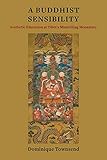A Buddhist sensibility : aesthetic education at Tibet's Mindröling Monastery / Dominique Townsend.
Material type: TextPublisher number: EB00820862 | Recorded BooksSeries: Studies of the Weatherhead East Asian Institute, Columbia UniversityPublisher: New York : Columbia University Press, [2021]Description: 1 online resource (xiii, 256 pages) : illustrationsContent type:
TextPublisher number: EB00820862 | Recorded BooksSeries: Studies of the Weatherhead East Asian Institute, Columbia UniversityPublisher: New York : Columbia University Press, [2021]Description: 1 online resource (xiii, 256 pages) : illustrationsContent type: - 9780231551052
- 0231551053
- Materials of Buddhist culture
- Smin-grol-gling (Monastery : Tibet Autonomous Region, China)
- Smin-grol-gling (Monastery : Tibet Autonomous Region, China)
- Aesthetics -- Religious aspects -- Buddhism
- Buddhism and art -- China -- Tibet Autonomous Region
- Buddhist monasticism and religious orders -- Education -- China -- Tibet Autonomous Region
- Esthétique -- Aspect religieux -- Bouddhisme
- Bouddhisme et art -- Chine -- Région autonome du Tibet
- HISTORY / Asia / General
- RELIGION / Buddhism / Tibetan
- Buddhist monasticism and religious orders -- Education
- Buddhism and art
- Aesthetics -- Religious aspects -- Buddhism
- History
- China -- Tibet Autonomous Region
- 294.3/709515 23
- BQ6349.S59 T69 2021eb
- online - EBSCO
| Item type | Current library | Call number | URL | Status | Notes | Barcode | |
|---|---|---|---|---|---|---|---|
 eBook
eBook
|
Biblioteca "Angelicum" Pont. Univ. S.Tommaso d'Aquino Nuvola online | online - EBSCO (Browse shelf(Opens below)) | Online access | Not for loan (Accesso limitato) | Accesso per gli utenti autorizzati / Access for authorized users | (ebsco)2458739 |
Browsing Biblioteca "Angelicum" Pont. Univ. S.Tommaso d'Aquino shelves, Shelving location: Nuvola online Close shelf browser (Hides shelf browser)
Revision of author's thesis (doctoral)--Columbia University, 2012, titled Materials of Buddhist culture : aesthetics and cosmopolitanism at Mindroling Monastery.
Includes bibliographical references and index.
Introduction: Buddhist aesthetics, the cultivation of the senses, and beauty's efficacy -- Historical background : laying the foundation for Mindröling -- A pleasure grove for the Buddhist senses : Mindröling takes root -- Plucking the strings : on style, letter writing, and relationships -- Training the senses : aesthetic education for monastics -- Taming the aristocrats : cultivating early modern Tibetan Buddhist literati and bureaucrats -- Epilogue: The next generation and beyond.
"Founded in 1676 during a cosmopolitan early modern period, Mindröling monastery became a key site for Buddhist education and a Tibetan civilizational center. Its founders sought to systematize and institutionalize a worldview rooted in Buddhist philosophy, engaging with contemporaries from across Tibetan Buddhist schools while crystallizing what it meant to be part of their own Nyingma school. At the monastery, ritual performance, meditation, renunciation, and training in the skills of a bureaucrat or member of the literati went hand in hand. Studying at Mindröling entailed training the senses and cultivating the objects of the senses through poetry, ritual music, monastic dance, visual arts, and incense production, as well as medicine and astrology. Dominique Townsend investigates the ritual, artistic, and cultural practices inculcated at Mindröling to demonstrate how early modern Tibetans integrated Buddhist and worldly activities through training in aesthetics. Considering laypeople as well as monastics and women as well as men, A Buddhist Sensibility sheds new light on the forms of knowledge valued in early modern Tibetan societies, especially among the ruling classes. Townsend traces how tastes, values, and sensibilities were cultivated and spread, showing what it meant for a person, lay or monastic, to be deemed well educated. Combining historical and literary analysis with fieldwork in Tibetan Buddhist communities, this book reveals how monastic institutions work as centers of cultural production beyond the boundaries of what is conventionally deemed Buddhist"-- Provided by publisher.
Description based on online resource; title from digital title page (viewed on March 03, 2021).
In English.









